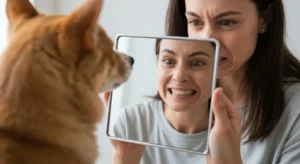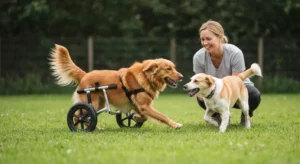July 31, 2025 — A groundbreaking study published this month in The International Journal of Comparative Veterinary Medicine delivers a stark warning to pet owners across the nation: the vast majority of companion animals are not getting enough physical or mental exercise, leading to what researchers have termed “Activity Deficit Disorder.” The findings from the comprehensive 2025 American Pet Activity & Sentience (APAS) Report, a multi-year project, indicate that as many as 65% of domestic dogs and a staggering 80% of indoor cats are living in a state of chronic under-stimulation. This deficit is directly linked to rising rates of pet obesity, diabetes, joint disease, and a spectrum of behavioral issues from anxiety to aggression.
The report, a collaboration between Cornell University’s College of Veterinary Medicine and the technology firm FitPaws Analytics, is being hailed as the most extensive investigation into pet activity levels ever conducted. Researchers utilized advanced activity-tracking collars on a cohort of over 10,000 pets in urban, suburban, and rural environments over a two-year period. The results have prompted veterinary professionals and animal behaviorists to call for an urgent re-evaluation of what constitutes adequate daily care for our companion animals.
The Data Doesn’t Lie: A Closer Look at the APAS Report
Unlike previous studies that relied on owner surveys, the APAS Report captured objective, moment-to-moment data, revealing a significant gap between perceived and actual activity. The trackers measured not only total steps and distance but also the intensity of movement, duration of high-energy play, and periods of complete rest.
“The data painted a picture that was, frankly, more alarming than we anticipated,” stated Dr. Anya Sharma, the lead author of the study and a research fellow at Cornell. “We discovered that the average dog’s ‘walk’ consists of 15 to 20 minutes of slow, low-intensity sniffing on a short leash, which provides minimal cardiovascular benefit. For many breeds, this is the equivalent of a human spending their entire day moving only from the couch to the refrigerator. It’s simply not enough to maintain physical or mental well-being.”
The study found that even dogs with access to a yard often failed to meet activity minimums. The data showed that most yard time was spent lying down or engaging in brief, sporadic movements rather than sustained exercise. “The yard is not a substitute for active engagement,” Dr. Sharma emphasized. “A dog is not going to run laps by itself. It needs interaction, motivation, and purpose, which are key components of effective exercises for pets.”
The situation for indoor cats was even more dire. The APAS report revealed that the average indoor cat spends over 90% of its day in a low-activity state, with brief bursts of movement primarily centered around trips to the food bowl or litter box. “We’ve created a very safe environment for our cats, but it’s often a mind-numbingly boring one,” said Dr. Ben Carter, a clinical veterinarian and certified animal behaviorist who consulted on the report. “Cats are incredible natural athletes and predators. When their instinct to hunt, climb, and explore is completely thwarted, it manifests in serious health and behavioral problems.”
Beyond Obesity: The Hidden Costs of Inactivity
While the link between a sedentary lifestyle and obesity is well-established, the APAS Report breaks new ground by quantifying the connection between inactivity and a host of behavioral and cognitive issues, which the authors have collectively labeled “Activity Deficit Disorder” (ADD).
“In my clinic, I see the symptoms of this every day,” explained Dr. Carter. “It’s the Border Collie that obsessively chases shadows, the Labrador that tears up furniture due to separation anxiety, or the cat that over-grooms itself until it has bald patches. These aren’t ‘bad’ pets; they are bored pets. Their brains and bodies are screaming for an outlet that they aren’t being given.”
The report’s data supports this clinical observation. FitPaws Analytics, the company providing the tracking technology, cross-referenced the activity data with detailed behavioral journals kept by the pet owners.
“The correlation was crystal clear,” said Michael Vance, CEO of FitPaws Analytics. “On days where a dog’s high-intensity activity was below a certain threshold, owner reports of destructive behavior, excessive barking, and restlessness spiked by over 200%. For cats, prolonged periods of inactivity were directly correlated with increased hiding, irritability, and litter box avoidance. This isn’t just about weight; it’s about mental health.”
The study concludes that a fundamental shift is necessary, moving away from a passive model of pet ownership toward an active one that prioritizes both physical exertion and cognitive enrichment as daily, non-negotiable necessities.
What This Means for Your Pet: An Expert-Backed Action Plan
The findings of the 2025 APAS Report may seem daunting, but the experts involved are quick to point out that addressing Activity Deficit Disorder is achievable for nearly every pet owner. The key is to be intentional and creative with your pet’s daily routine. Below is a comprehensive guide with vet-approved strategies and specific exercises for pets, designed to combat inactivity and enrich your animal’s life, based directly on the study’s conclusions.
-
1. Redefine ‘The Walk’: Quality Over Quantity for Dogs
The study showed that a slow, repetitive walk is insufficient. The goal is to make every walk an adventure for the body and the mind. Aim for at least 30-60 minutes of engaged walking per day, broken into two or more sessions if needed.
- Embrace the “Sniffari”: Dr. Sharma’s team noted the cognitive benefits of scent. Use a long lead (10-15 feet) in a safe area and let your dog lead the way. Allowing them to deeply investigate smells is mentally exhausting and highly rewarding. This type of walk is for them, not for you.
- Incorporate Urban Agility: You don’t need a formal course to challenge your dog’s body. During your walk, encourage them to hop onto a sturdy park bench (if allowed and safe), weave through poles, or place their paws up on a low wall. This builds confidence and works different muscle groups.
- Practice Interval Training: Just like with human fitness, intervals are highly effective. Mix periods of brisk walking or jogging (30-60 seconds) with periods of slower recovery walking (1-2 minutes). This is a fantastic way to improve cardiovascular health without needing to run for miles.
- Pack Brain Games: A walk is a perfect opportunity for training. Stop periodically to practice commands like “sit,” “stay,” and “look at me.” This reinforces your bond and forces your dog to engage their brain amidst distractions.
-
2. Activate the Indoor Hunter: Purposeful Exercises for Cats
For indoor cats, the challenge is to recreate the predatory sequence: hunt, catch, kill, and eat. The APAS report stressed that random toys lying on the floor do little to combat feline boredom.
- Master the Feather Wand: A wand toy is one of the best tools for cat exercise, but only if used correctly. Make the toy act like prey. Have it scurry behind furniture, pause, twitch, and then dart across the room. Let your cat stalk and chase it. End each session by allowing them to “catch” the prey, followed by a high-value treat to complete the cycle. Aim for two 15-minute sessions per day.
- Make Mealtimes a Workout: Ditch the simple food bowl. Puzzle feeders force cats to use their paws and brains to get their food, mimicking the work of extracting meat from a carcass. Start with easy puzzles and gradually increase the difficulty. You can also hide small portions of their meal around the house, encouraging them to “hunt” for it.
- Go Vertical: Cats naturally love to climb and observe from high places. Investing in a tall, sturdy cat tree (at least 5-6 feet) is an investment in their health. Wall-mounted shelves and perches can also create a “cat superhighway” that encourages climbing, jumping, and exploration.
- Rotate Toys and Scents: Don’t leave all the toys out all the time. Keep a special stash that only comes out during playtime to maintain novelty and excitement. Introduce new scents like silver vine or catnip-sprayed cardboard boxes for sensory enrichment.
-
3. Introduce Cognitive Enrichment: A Workout for the Brain
The APAS report was clear that physical exercise is only half the battle. Mental fatigue is just as important as physical fatigue for a well-behaved pet. These exercises for pets are low-impact and perfect for rainy days, senior animals, or dogs on restricted activity.
- Nose Work Games: A pet’s sense of smell is powerful. For dogs, have them sit and stay while you hide a few high-value treats around a room. Then release them with a cue like “Find it!” For cats, you can do the same with their favorite treats or a catnip toy.
- DIY Food Puzzles: You don’t need to buy expensive toys. Place treats in the cups of a muffin tin and cover them with tennis balls or other toys that your pet has to remove. A simple cardboard box filled with crumpled paper and scattered treats can provide minutes of stimulating fun.
- Teach a New Trick: The process of learning is fantastic mental exercise. Spend 5-10 minutes each day teaching your dog or cat a new skill. For dogs, this could be “shake,” “roll over,” or “go to your bed.” Many cats can be taught to “sit,” “high-five,” or even come when called.
-
4. Tailor the Activity to the Animal: Breed, Age, and Health
A one-size-fits-all approach to exercise can be ineffective and even dangerous. Dr. Carter urges all owners to consider their pet’s individual needs.
- High-Energy Breeds: Breeds like Border Collies, Australian Shepherds, and Belgian Malinois were bred to work all day. They need more than just a walk. Consider advanced activities like formal agility classes, dock diving, or canine sports like Treibball or flyball to give them a “job.”
- Brachycephalic (Short-Nosed) Breeds: Pugs, French Bulldogs, and Persian cats can overheat easily and have breathing difficulties. Their exercise should be low-impact and conducted during the coolest parts of the day. Swimming (with a life vest) is an excellent choice, as are indoor scent games and puzzle toys.
- Senior Pets: Exercise is crucial for maintaining muscle mass and joint mobility in older pets, but it needs to be gentle. Soft, grassy walks, swimming, and physical therapy exercises are ideal. Keep their minds sharp with easy food puzzles and scent games.
- Puppies and Kittens: Young animals need multiple short bursts of play, not long, strenuous exercise sessions. Over-exercising a puppy can damage their developing growth plates. Focus on play, socialization, and short training sessions.
Important: Always consult with your veterinarian before beginning any new or strenuous exercise regimen with your pet to ensure it is safe and appropriate for their specific health status.












